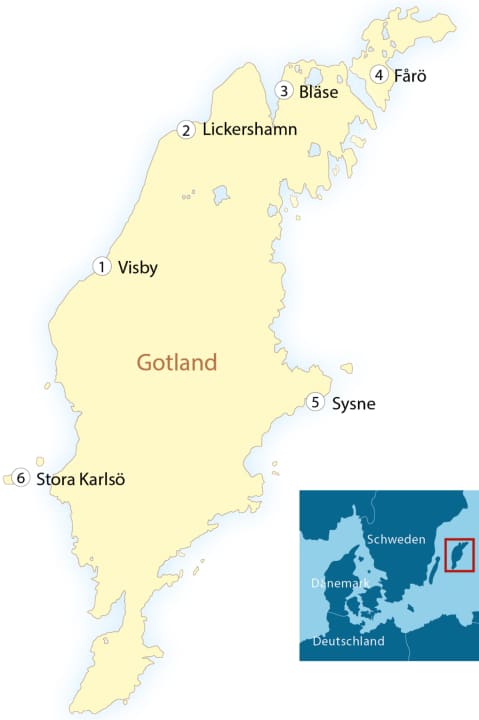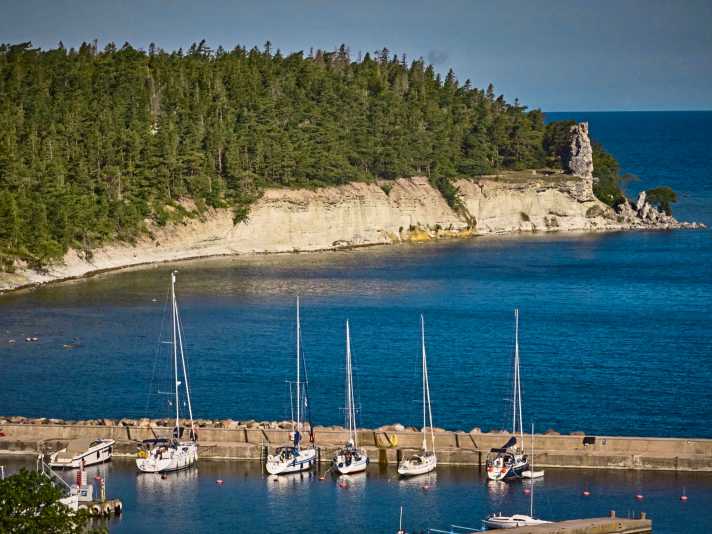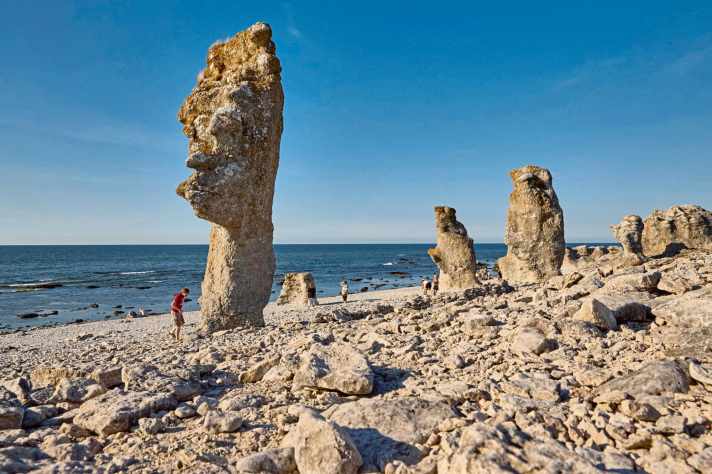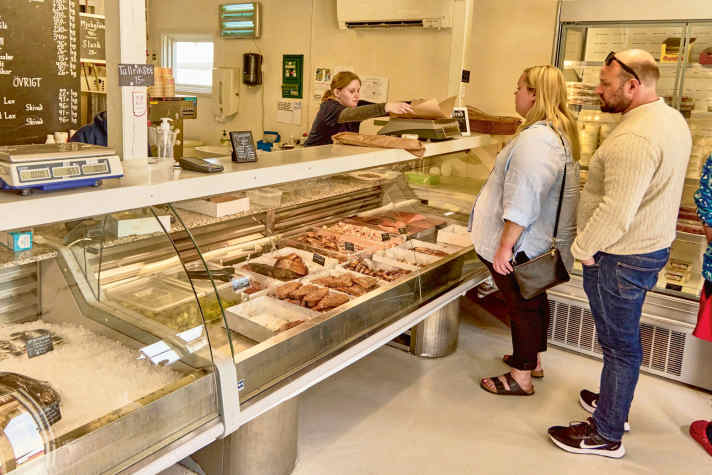





The light-coloured stripe on the horizon looks like a white band between the sky and the sea. Is it a cloud bank, sea mist or a mirage? The navigator's knowledge and the view through the binoculars prove otherwise: Land in sight! The west coast of Gotland shows off its long sandy limestone western flank - the white sedimentary rock is the island's trademark.
Around 50 nautical miles from the mainland lies Sweden's exotic beauty, some 176 kilometres long and 52 kilometres wide. With a coastline of 800 kilometres, Gotland is Sweden's largest island and the largest island in the Baltic Sea. The Follingbo beacon is visible in the south-east. The course is right and the harbour of Visby is within easy reach. In the spacious outer harbour of the busy ferry port, protected from the wind and waves, there is enough space to hoist the sails and make the lines and fenders ready. But there is constant choppy water here - commercial vessels and yachts keep things moving and tug at the mooring lines of the yachts on the pier.
More destinations in the Baltic Sea:
"Hey, just follow me - I'll show you a quiet spot and help you tie up!" The friendly voice belongs to a young woman in a rubber dinghy who, on behalf of the harbour master, guides arriving yachts to the rear, quieter areas of the harbour basin. Here, stern buoys are lined up like a string of pearls. She skilfully manoeuvres the boat, brings it into line with the other yachts and helps to pull the stern line through the eyelet. "Welcome to Visby - this will be the best time of your trip!" she says with a smile. It's clear: this is Gotland!
"The west coast shows off its long sandy limestone western flank - the white sedimentary rock is the trademark of Gotland."
The inhabitants of Sweden's most popular island are self-confident. No wonder - the island is known as Sweden's "sunshine island", with mild summers and the most hours of sunshine in the country. But Gotland offers more than just a pleasant climate. Visby, the island's capital, is a fascinating melting pot.
Gotland brings geological history to life
Hip cafés, restaurants and creative boutiques meet an old town that looks like a huge open-air museum: cobblestones, imposing city walls, churches and ruins bear witness to the town's rich history. "This town was never ordinary - neither today nor in the heyday of the Hanseatic League in the 14th century," says Edda Lindström, who organises nature and culture walks. "There was always socialising, trade, art and crafts here. Today, Stockholm and international guests add to the special flair. Gotland is a magnet for culture and nature lovers!"
Gotland is also unique in geological terms. Over 400 million years ago, the island was still a coral reef close to the equator. It moved to its present location as a result of continental drift. The best place to see the remains of this reef and experience geological history in real time is the island of Fårö in the north-east of Gotland. The limestone coast is home to the striking rauks - freestanding columnar rock formations. They are formed by the erosion of softer rock, which leaves behind the harder limestone layers. Fossilised corals, shells and other sea creatures are scattered all over the beaches.
"The white sea wall shines from afar, while the green junipers accentuate the landscape."
Island is a bright stripe on the horizon
The best harbour to experience these natural wonders up close is Lauters gästhamn. The white sea wall shines from afar, while the green junipers accentuate the landscape. From there, it's just a kilometre along the coast to the impressive rocky outcrops of Digerhuvud. The diversity of the large island can be discovered by boat, but the 120 nautical miles around the island are not just a simple coastal journey. "Depending on the wind, a steep wave can build up, and near the coast there can also be bottom seas, as it can be very shallow there," says Lasse Peterson from Södertalje. There are only a few well-protected anchor bays, wind and waves run around the island. Lasse is in the cruising department of Svenska Kryssarklubben and has been an experienced Gotland sailor for decades. "The harbours and entrances on the east coast in particular are very shallow, and the winter storms shift sandbanks and thus the depth contours."
On the other hand, the harbours there are very remote, and if you love solitude and simplicity and don't have your keel hanging too low, this is the place for you.
A stark contrast to the otherwise idyllic landscape are the industrial and harbour facilities that were built for the extraction of limestone for the cement industry. The scars are visible almost everywhere on the island, and in the harbours of Klintehamn and Slite, the economic face of Gotland is dominant. "Some harbours are really not a thing of beauty, but offer every service that water sports enthusiasts need," explains Lasse. But Lasse also has some romantic tips: "Sysne is my favourite harbour. It has the best fishmongers in the world and otherwise just white, secluded beaches." That's exactly what Gotland is: a bright strip on the horizon - like a white ribbon between the sky and the sea.
Worth knowing: Facts and tips about Gotland
Sweden's largest island has a completely different character to the rest of the country. Its rich history in particular makes Gotland unique: in the Middle Ages, it was an important hub of the Hanseatic League. The medieval old town of Visby with its well-preserved city walls, church ruins and picturesque alleyways has been declared a UNESCO World Heritage Site.
Rare orchid species and a rich bird life make the island a special place for nature lovers. Fårö, the small sister island, is world-famous as the home of director Ingmar Bergman, whose films capture the barren beauty of the region.
Regatta spectacle
The Gotland Runt is a highlight for offshore regatta sailors and leads from Sandhamn in the Stockholm archipelago around the island and back again. Every year in June/July, several hundred sailors from all over Europe come to complete the 350 nautical mile route. Read more at www.ksss.se/en/gotlandrunt/
Climate
The temperate climate is mainly characterised by the Baltic Sea, which provides a cooling breeze in summer and moderate warmth in winter. The number of hours of sunshine is highest in May and June. In winter, temperatures rarely fall far below freezing, while average temperatures of around 18 °C prevail in summer. Rainfall is moderate, with late summer being the wettest time.
Attention, season!
The island is like a suburb of Stockholm: at weekends and during the holiday season from mid-June to August, the harbour and on land are packed. If you can manage it, you should choose an alternative time for your cruise. In September it is usually still warm and you can get a table in the restaurant without a reservation.
Navigation and harbours
Visby is the maritime heart of the island, with the most space and the best facilities. However, it can also be crowded and noisy here. Alternatives: Many harbours are former industrial sites and not exactly idyllic. But there are enchanted places for yachts with a draught of up to two metres in the small old fishing piers, especially on the east side. The price for experiencing nature and seclusion is lower standards of sanitation and service. However, it is not advisable to call at the small harbours in strong onshore winds.
Mobility and shore leave
From Stockholm and Oskarshamn, large fast ferries connect the island with the mainland. Gotland is very extensive and many places are best explored by bike, bus or hire car. Bicycle hire and car hire are available at the harbour or airport. The entire island is served by regional buses, all departing from Visby.
Literature
- Svenska Kryssarklubben Gotlandkust, in Swedish;
- Cruising guide Sweden 2, Delius Klasing Verlag, ISBN: 3-667-11660; 39,90 Euro
- Hamnguiden 7 Landsort - Skanör. ISBN: 9788292284360; 82,90 Euro
Sea charts
- Sjöfartsverket, Swedish East Coast series Map no.: S;
- East Coast Sweden 2, Recreational Boat Charts Set 12 by Delius Klasing

1 Visby - box seat in the Baltic Sea
The largest city on Gotland is known for its well-preserved medieval old town. In the Middle Ages, it was an important trading centre of the Hanseatic League, and Visby has been a UNESCO World Heritage Site since 1995.
- Shore leave: picturesque old town and an impressive town wall from the 13th century. Beach club, cafés, restaurants, arts and crafts. The town is particularly famous for the "Medieval Week" (3-10 August 2025), Europe's largest medieval spectacle.
- Nautical: Gotland's most popular guest harbour and the fishing harbour are located in the inner harbour. Lively ferry traffic and cruise ships. Water depth: two to six metres.
The harbour is well protected - except in strong south-westerly winds. A dinghy from the harbour master allocates free places or book in advance by calling 07 36/00 63 00 or using the Dockspot app. Good service facilities, very central.
2 Lickershamn - silence in the north

Small, cosy fishing harbour on the striking cliffs with the famous Jungfrun rock formation.
- Shore leave: Hike through the forest and heathland above the cliffs or to the pebble beach. Sauna and restaurant at the harbour.
- Nautical: 20 berths on the northern jetty, which offers good protection except in north-westerly winds. Water depth: two to three metres (drifting sand can lead to changes!).
3 Bläse - limestone quarry and industrial monument
The small jetty at the Bläse Kalkbruk industrial monument is only an exciting spot at second glance. This is where the island's former economic importance and the landscape based on lime become visible.
- Shore leave: The limestone museum, the historic railway to the quarry and a café as well as the wide stone beach and the nearby Opal Lake.
- Nautical: Some moorings (alongside or with a stern anchor) on the old pier, often in a packet. Limited water and electricity supply. Booking and payment via psidan.se. Unsettled in westerly and northerly winds. Anchoring possible in calm weather south of the jetty at three to six metres.
4 Fårö - geological heritage

On the small island to the north-west of Gotland, the beach is characterised by rauks. The limestone columns, which are over ten metres high, are evidence of a large coral reef that was here around 490 million years ago.
- Shore leave: The island can be explored by bike, bus or hire car, and a ferry runs a shuttle service to Gotland. The highlight is the more than one hundred bizarre limestone pillars that have been shaped by the sea and wind over thousands of years.
- Nautical: Small Lauterhorn fishing harbour with around 25 berths for sailing yachts up to 14 metres, water depth: three metres. Facilities: basic, small restaurant and café, bus stop within walking distance.
5 Sysne - Fresh catch from the oven

Not a highlight as a harbour, but the fish smokehouse is worth a visit!
- Shore leave: Fresh fish from the Fiskbutiken and the fishing museum.
- Nautical: Very small harbour for about eight yachts in a packet. Alongside the pier in front of the fishing boat in about four metres of water. Electricity ashore, dry toilet and water.
6 Stora Karlsö - geological dream island
Stora Karlsö is one of the oldest nature reserves in the world and is famous for its rich bird life. Geologically it is an Eldorado. Fossils and stones are not allowed! The magnificent lighthouse keeper's house from the 1930s is modelled on a French building and is classified as an architectural monument.
- Shore leave: A circular walk is the best way to explore the island - rock formations, cliffs and grottos. Afterwards, have lunch in a restaurant or visit a museum. If you're not travelling to the island on your own, take the ferry from Klintehamn.
- Nautical: There is a concrete pier to the north of the small island where the ferry docks, leaving space for around three yachts in a water depth of one and a half to two and a half metres. A reef to the north of the island protects the area from swell, but the island can only be approached in calm weather. Water, toilet and showers at the youth hostel.

